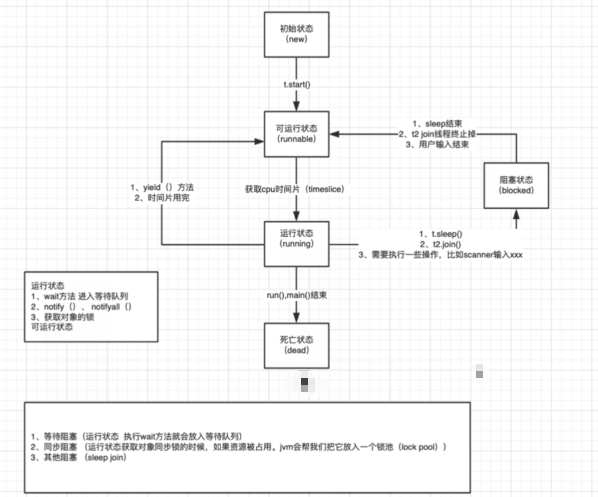1、查看源码
public enum State { /** * Thread state for a thread which has not yet started. */ NEW, /** * Thread state for a runnable thread. A thread in the runnable * state is executing in the Java virtual machine but it may * be waiting for other resources from the operating system * such as processor. */ RUNNABLE, /** * Thread state for a thread blocked waiting for a monitor lock. * A thread in the blocked state is waiting for a monitor lock * to enter a synchronized block/method or * reenter a synchronized block/method after calling * {@link Object#wait() Object.wait}. */ BLOCKED, /** * Thread state for a waiting thread. * A thread is in the waiting state due to calling one of the * following methods: * <ul> * <li>{@link Object#wait() Object.wait} with no timeout</li> * <li>{@link #join() Thread.join} with no timeout</li> * <li>{@link LockSupport#park() LockSupport.park}</li> * </ul> * * <p>A thread in the waiting state is waiting for another thread to * perform a particular action. * * For example, a thread that has called <tt>Object.wait()</tt> * on an object is waiting for another thread to call * <tt>Object.notify()</tt> or <tt>Object.notifyAll()</tt> on * that object. A thread that has called <tt>Thread.join()</tt> * is waiting for a specified thread to terminate. */ WAITING, /** * Thread state for a waiting thread with a specified waiting time. * A thread is in the timed waiting state due to calling one of * the following methods with a specified positive waiting time: * <ul> * <li>{@link #sleep Thread.sleep}</li> * <li>{@link Object#wait(long) Object.wait} with timeout</li> * <li>{@link #join(long) Thread.join} with timeout</li> * <li>{@link LockSupport#parkNanos LockSupport.parkNanos}</li> * <li>{@link LockSupport#parkUntil LockSupport.parkUntil}</li> * </ul> */ TIMED_WAITING, /** * Thread state for a terminated thread. * The thread has completed execution. */ TERMINATED; }
一共有六种状态。
2、六种状态
(1)新建(NEW)
new关键字创建一个线程之后,该线程处于新建状态。jvm为线程分配内存,初始化成员变量值
(2)运行(RUNABLE)
就绪(ready):
当线程对象调用了start()方法后,该线程处于就绪状态。jvm为线程创建方法栈和程序计数器,等待线程调度器调度
运行(running):
就绪状态的线程获得CPU资源,开始运行run方法,该线程处于运行状态
(3)阻塞
线程调用sleep方法主动放弃所占用的处理器资源
线程调用了一个阻塞式IO方法,在该方法返回之前,该线程被阻塞
线程试图获得一个同步锁(同步监视器),但是该锁正在被其它线程持有
线程正在等待某个通知
public class Test { static class Toilet{ public synchronized void use(){ try { Thread.sleep(5000); } catch (InterruptedException e) { e.printStackTrace(); } } } public static void main(String[] args) throws InterruptedException { Toilet toilet=new Toilet(); Thread a=new Thread(){ public void run(){ toilet.use(); } }; a.start(); Thread.sleep(1000); Thread b=new Thread(){ public void run(){ toilet.use(); } }; b.start(); Thread.sleep(1000); System.out.println(b.getState()); } }
(4)等待(WAITING)
处于这种状态的线程不会被分配CPU执行时间,它们要等待被显式地唤醒,否则会处于无限期等待的状态。例如:线程拿到锁之后发现当前线程的执行条件不满足,需要暂时停止执行,以便让CPU资源供其他线程执行
public class Test { static class TEst{ public synchronized void use(){ try { System.out.println("a"); System.out.println("b"); wait(); } catch (InterruptedException e) { e.printStackTrace(); } } } public static void main(String[] args) throws InterruptedException { TEst tEst=new TEst(); Thread thread=new Thread(){ public void run(){ tEst.use(); } }; thread.start(); Thread.sleep(1000); System.out.println(thread.getState()); } }
如:上面的程序缺乏b的时候就会进入等待状态
(5)超时等待
处于这种状态的线程不会被分配CPU执行时间,不过无须无限期等待被其他线程显示地唤醒,在达到一定时间后它们会自动唤醒
public class Test { static class TEst{ public synchronized void use(){ try { System.out.println("a"); System.out.println("b"); wait(1000); } catch (InterruptedException e) { e.printStackTrace(); } } } public static void main(String[] args) throws InterruptedException { TEst tEst=new TEst(); Thread thread=new Thread(){ public void run(){ tEst.use(); } }; thread.start(); Thread.sleep(1000); System.out.println(thread.getState()); } }
a
b
TIMED_WAITING
(6)死亡
线程会以如下的三种方式结束,结束后就进入死亡状态:·
run()或call()方法执行完成,线程正常结束
线程抛出一个未捕获的Exception或Error
调用该线程的stop方法来结束该线程,该方法容易导致死锁,不推荐使用
3、线程的生命周期

4、线程的状态举例
public class StateTest implements Runnable {
@Override
public void run() {
}
public static void main(String[] args) {
Thread thread = new Thread(() -> {
for (int i = 1; i < 5; i++) {
try {
Thread.sleep(1000);
} catch (InterruptedException e) {
e.printStackTrace();
}
}
System.out.println("---------------");
});
Thread.State state = thread.getState();
System.out.println(state);
thread.start();
state = thread.getState();
System.out.println(state);
while (state!=Thread.State.TERMINATED){//只要线程不终止,就一直输出线程的状态
try {
Thread.sleep(100);
} catch (InterruptedException e) {
e.printStackTrace();
}
state=thread.getState();
System.out.println(state);
}
}
}
测试:
NEW
RUNNABLE
TIMED_WAITING
TIMED_WAITING
TIMED_WAITING
TIMED_WAITING
TIMED_WAITING
TIMED_WAITING
TIMED_WAITING
TIMED_WAITING
TIMED_WAITING
TIMED_WAITING
TIMED_WAITING
TIMED_WAITING
TIMED_WAITING
TIMED_WAITING
TIMED_WAITING
TIMED_WAITING
TIMED_WAITING
TIMED_WAITING
TIMED_WAITING
TIMED_WAITING
TIMED_WAITING
TIMED_WAITING
TIMED_WAITING
TIMED_WAITING
TIMED_WAITING
TIMED_WAITING
TIMED_WAITING
TIMED_WAITING
TIMED_WAITING
TIMED_WAITING
TIMED_WAITING
TIMED_WAITING
TIMED_WAITING
TIMED_WAITING
TIMED_WAITING
TIMED_WAITING
TIMED_WAITING
TIMED_WAITING
TIMED_WAITING
---------------
TERMINATED